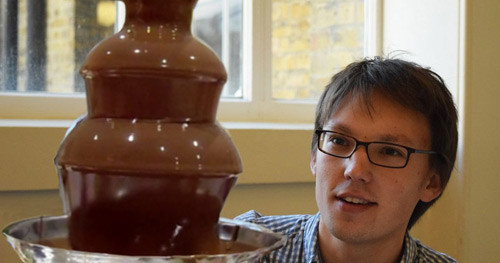
Dark flow: Adam Townsend ponders the dynamics of a chocolate fountain. (Courtesy: London Mathematical Society)
By Tushna Commissariat
When most people look at a chocolate fountain in a restaurant or maybe at a party, they are mostly thinking about all the yummy treats they can dunk into the liquid-chocolate curtain. But when a physicist or a mathematician looks at one, they can’t help but notice some of the interesting fluid dynamics at play – most visible is how the curtain of chocolate does not fall straight down, rather it pulls inwards, and that melted chocolate is a non-Newtonian fluid.
University College London (UCL) student Adam Townsend decided to work on this topic for his MSci project and has now published a paper on his findings in the European Journal of Physics. To study the inflow effect, he looked into some classic research on “water bells”, where the same flow shape is seen. “You can build a water bell really easily in your kitchen,” says UCL physicist Helen Wilson, who was Townsend’s MSci project supervisor and the paper’s co-author. “Just fix a pen vertically under a tap with a 10p coin flat on top and you’ll see a beautiful bell-shaped fountain of water.”
The duo studied the pumped flow of the chocolate up the pipe to the top of the fountain, the chocolate flow over each plastic tier or dome and finally the freely falling curtain flow between the domes. In each case, the melted chocolate flows in different ways, making it an interesting way to introduce complex fluid mechanics concepts to students, say the researchers.
The central, pumped flow showed the benchmark effects of shear-thinning, while the dome flow can be modelled as a thin-film flow. In both the water bell and the chocolate fountain, it is mainly the effects of surface tension that cause the inward flow, according to the researchers.
“Both the chocolate-fountain and water-bell experiments are surprisingly simple to perform,” says Wilson. “However, they allow us to demonstrate several aspects of fluid dynamics, both Newtonian and non-Newtonian.”
“It’s serious maths applied to a fun problem,” says Townsend, adding that he has been talking about his project at maths events around London for the last few years. “If I can convince just one person that maths is more than Pythagoras’ theorem, I’ll have succeeded. Of course, the same mathematics has a wide use in many other important industries – but none of them are quite as tasty as chocolate.”
One can’t help but wonder just how many fountains of chocolate the duo were forced to consume – all in the name of science, of course. Suffice to say this is my kind of experiment!
Trackback: The Physics of a Chocolate Fountain | Your Daily Buzz
Apart from gravity, in the case of chocolate both the viscosity and the surface tension are in action, but for water only the surface tension acts; this should lead to more varied-in-form fountains in the case of the “mouth watering” chocolate than water.
Trackback: Dipping into the physics of a chocolate fountain – MyPhysNet